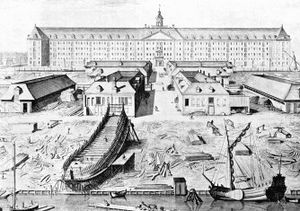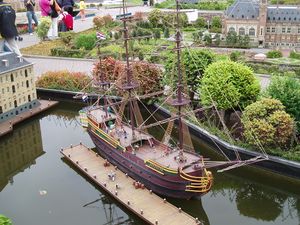Amsterdam (VOC ship)
| Ship replica of the Amsterdam The ship replica of the Amsterdam in the city of Amsterdam in temporary berthing in front of the science Center NEMO | |
| Career (Dutch Republic) | |
|---|---|
| Name: | Amsterdam |
| Namesake: | The city of Amsterdam |
| Owner: |
Dutch East India Company Chamber of Amsterdam |
| Completed: | 1748 |
| Maiden voyage: | Texel–Batavia |
| Fate: | Wrecked in a storm in the English Channel on 26 January 1749 |
| General characteristics [1] | |
| Type: | East Indiaman |
| Displacement: | 1100 tons |
| Length: | 48.0 metres (157.5 ft) |
| Beam: | 11.5 metres (38 ft) |
| Height: | 56.0 metres (183.7 ft) |
| Draught: | 5.5 metres (18 ft) |
| Armament: | 42 guns |
The Amsterdam was a 18th century cargo ship of the Dutch East India Company. The ship started its maiden voyage from Texel to Batavia on 8 January 1749, but was wrecked in a storm on the English Channel on 26 January 1749. The shipwreck was discovered in 1969 in the bay of Bulverhythe, United Kingdom, and is sometimes visible during low tides. The wreck site is protected under the Protection of Wrecks Act since 1974. Some of the findings from the site are in the Shipwreck and Coastal Heritage Centre in Hastings. A replica of the ship is on display in Amsterdam.
Contents
Ship
The Amsterdam was an East Indiaman or "mirror return ship" (Dutch: spiegelretourschip) built for transport between the Dutch Republic and the settlements and strongholds of the Dutch East India Company in the East Indies. On an outward voyage these ships carried guns and bricks for the settlements and strongholds, and silver and golden coins to purchase Asian goods. On a return journey the ships carried the goods that were purchased, such as spices, fabrics, and china. In both directions the ships carried victuals, clothes, and tools for the sailors and soldiers on the ship. On an outward voyage of eight months, the ships were populated by around 240 men, and on a return journey by around 70.[1]
The Amsterdam was built in the shipyard for the Amsterdam chamber of the Dutch East India Company in Amsterdam.[2] The ship was made of the wood of oaks.[1]
Maiden voyage
The maiden voyage of the Amsterdam was planned from the Dutch island Texel to the settlement Batavia in the East Indies. The ship, commanded by the 33-year-old captain Willem Klump, had 203 crew, 127 soldiers, and 5 passengers.[2] The Amsterdam was laden with textiles, wine, stone ballast, cannon, paper, pens, pipes, domestic goods and 27 chests of silver guilder coins. The whole cargo would be worth several million euros in modern money.[citation needed]
On 15 November 1748 the ship made its first attempt but returned on 19 November 1748 due to an adverse wind. The ship made a second attempt on 21 November 1748, which also failed and from which the ship returned on 6 December 1748. The third attempt was made on 8 January 1749.[2] The Amsterdam had problems in the English Channel tacking into a strong westerly storm. For many days she got no further than Beachy Head near Eastbourne. Black Death appeared amongst the crew and a mutiny broke out. Finally the rudder broke off and the ship, helpless in a storm, grounded in the mud and sand of in the bay of Bulverhythe on 26 January 1749, 5 km to the west of Hastings.[citation needed]
She began to sink into the mud, where much of the keel remains today, perfectly preserved. Some of the cargo, including silver coinage, was removed for safekeeping by local authorities. There was some looting and English troops had to be called in to bring the situation to order. The crew were looked after locally before being returned to the Netherlands.[citation needed]
Shipwreck
In 1969, the Amsterdam was discovered after being exposed by a low spring tide. It is the best-preserved VOC ship ever found. Archaeologist Peter Marsden did the first surveying of the wreck, and he advised further excavation.
The wrecksite was designated under the Protection of Wrecks Act on 5 February 1974.
The VOC Ship Amsterdam Foundation started researching the wreck, followed by major excavations in 1984, 1985 and 1986, during which huge numbers of artifacts were found. Although the wreck is submerged in the sand and mud of the beach (and is even visible at very low tides), much of the excavation was done by divers, for whom a small tower was constructed near the wreck. Additionally the wreck was surrounded by an iron girder frame. The archeological output was so dense that new ways of researching needed to be developed, all of which were needed to understand the technological, socio-economic and cultural features of the VOC. Some of the finds are on show at the Shipwreck and Coastal Heritage Centre in Hastings, East Sussex, UK. The wreck is protected and diving on it or removing timbers or any artifacts is forbidden. The ship may be visited as the timbers are exposed at very low tides in the sand just opposite the footbridge over the railway line at Bulverhythe.
Ship replica
A replica of the ship was built in Iroko wood by 400 volunteers using tools of the period, between 1985 and 1990 at Lelystad. It was floated to Amsterdam and is usually moored next to the Netherlands Maritime Museum, where it's open to visitors. The museum is currently closed due to undergoing renovations and the replica is temporarily moored at the nearby NEMO science center and can be visited there. As for the original ship, there had been hopes in the 1980s that the Dutch Government, which still owns it, might excavate the whole wreck and return it for restoration and display in Amsterdam, like the Regalskeppet Vasa in Sweden, or the Mary Rose in Portsmouth, but the funds were not forthcoming. Several decks and much of the bowsprit lie submerged in the mud and are in remarkably good condition, being naturally preserved by the mud and much of the cargo is still aboard.
Popular culture
The comic book Angst op de "Amsterdam" of Spike and Suzy is about the Amsterdam. The book was published in 1985 in The Red Series of Spike and Suzy.
In the miniature park Madurodam in The Hague is a model of the Amsterdam on a scale of 1:25.
References
- ↑ 1.0 1.1 1.2 "Eastindiaman Amsterdam". Nederlands Scheepvaartmuseum. http://www.scheepvaartmuseum.nl/index.php?PageID=189. Retrieved 2008-04-25.
- ↑ 2.0 2.1 2.2 Overbeek, J.H.D. van. "Gegevens VOC-schip Amsterdam 1748". De VOCsite. http://www.vocsite.nl/schepen/detail.html?id=10038. Retrieved 2008-04-28.
External links
| Amsterdam (VOC ship)
]]- Amsterdam Wreck Shore at the Shipwreck and Coastal Heritage Centre
- Eastindiaman Amsterdam at the Nederlands Scheepvaartmuseum
- (Dutch) Gegevens VOC-schip Amsterdam 1748
- The VOC ship Amsterdam Foundation (Dutch)
- Webcam of the Foundation pointing at the wreck of the 'Amsterdam'
Coordinates: 52°22′21.00″N 4°54′51.48″E / 52.3725°N 4.9143°E
de:Amsterdam (1749) fr:Amsterdam (voilier) it:Amsterdam (nave) nl:Amsterdam (schip)
- Pages with broken file links
- All articles with unsourced statements
- Articles with unsourced statements from April 2008
- Articles with invalid date parameter in template
- History of the Netherlands
- Maritime incidents in 1749
- Merchant ships of the Netherlands
- Protected Wrecks of the United Kingdom
- Replica ships
- Individual sailing vessels
- Sailing ships
- Shipwrecks in the English Channel
- Ships of the Dutch East India Company
- 1740s ships




